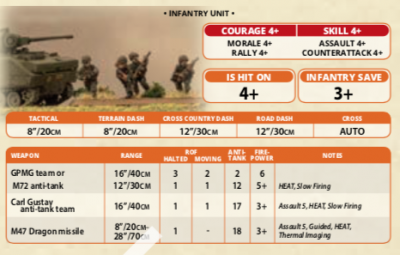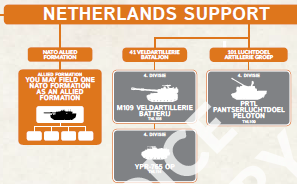Free Nations: Dutch
By NDNG_Dane and Glenn Goddard
Everyone loves the Dutch! So says Austin Powers anyway. Anyone who has been to the Netherlands knows that the Dutch language seems to be half German and half English. Apparently, so is their military. Want to have the power and armor of the Leo 2? You get ’em. Want the staying Gone to Ground while shooting TOW missiles that the American M-901 gets with the Hammerhead rule? You get that too.
History of the Dutch in NATO
The rise and fall of Dutch domination of European trade markets. Once a global trade powerhouse, for example, in 1670 the Dutch Merchant Marine shipped 568,000 tons of food, spices, tools, and trade goods. That was more than the maritime shipments of France, England, Scotland, the entire Holy Roman Empire, Spain and Portugal combined.
Dutch dominance in the world trade market was in steady decline through the 19th Century. Decades of incessant warfare eventually exhausted the Netherlands’s resources. The burden of taxation to maintain the Merchant Marine and the armed forces, in particular, drove down the Dutch economy. High indirect taxes on consumption, led to correspondingly increased wages and diminished competitiveness for producers. This overburden of taxes led to a change in national policy from protecting cargo shipments with Merchants Marines and a large standing army, to a new national policy of neutrality and passivity. This new policy of neutrality started in 1830 with the secession of Belgium, formerly the South Netherlands.
After World War 1, The Dutch Government believed it would be able to rely on its neutrality. However, the government also begin to work on plans for the defense of the Netherlands in case neutrality could not be realized. These plans included building fortified positions all along the border. The Netherlands defensive plans also included the “New Dutch Waterline”, an area to the east of Amsterdam, which would be flooded in an extreme situation.
The Netherlands neutrality ended on 10 May 1940, with the invasion by Nazi Germany. On 14 May 1940, Netherland surrendered to Germany. The Dutch government and the royal family fled to the Great Briton and Canada.
Dutch soldiers dismount a CV 90 combat vehicle to conduct an assault in an urban environment during Exercise Allied Spirit I at the U.S. Army Joint Multinational Readiness Center’s Hohenfels Training Area, Germany, Jan. 20, 2015. (U.S. Army photo by Visual Information Specialist Markus Rauchenberger/released)After the liberation of the Netherlands and the Allied Victory of WWII, the Dutch Government believed it could again revert to its national policy of neutrality. However, the world had changed. Although the remaining Allied Forces in Europe were constabulary in nature, Forces of the Soviet Union maintained a war footing. The fear of Soviet expansion and communism was pervasive.
For the Dutch Government, joining NATO was a logical next step. Other reasons the join NATO included the protection of other NATO nations and its American leadership as well as the possibility to receive American Financial assistance through the Marshall plan. The Netherlands abandoned its preference for neutrality and in 1948, became a founding member of NATO. In recognition of its NATO obligation, the Netherlands established the Dutch Field Forces Command in 1951 and the First Dutch Army Corps (le Legerkorps (1LK) in 1952.
First Dutch Army Corps
Leo 1The First Dutch Army Corps, mission is to defend a sector, approximately 100 kilometers wide and 170 kilometers deep in northwestern Germany. During peace, the 1LK military strength is approximately 35,000 soldiers. After wartime mobilization, 1LK military strength reaches 90,000 soldiers. During war, 1LK falls under the wartime Operational Command of NATO’s Northern Army Group (NORTHAG). The 1LK consists of 10 semi-independent brigades (3 Armored and 6 Mechanized Infantry). The 1LK is unique among Western armies, in that the 1LK Brigades, not divisions, are operationally and functionally self-supporting.
In Free Nations, the Netherlands 1. Korps is called out as 41 Pantserbrigade combat brigade from the 4th. Divisie.
The 41 Pantserbrigade consists of three combat battalions with divisional support options and an option for any NATO Allied Formation, as well as, West German support options.
Building Your Force
You have four types of formations that you can have. In addition, you can also have any of the NATO formations too. The formations types are Leo2 Co., Leo1 Co., Infantry Co., and Recon Co.
Leo 2
Note that in this formation, you can make your mandatory platoons one tank and one infantry which is not the case with the Leo1 formation. This is probably a good place to mention that the Dutch Leo2s are only 10 points, not 11 like the West Germans. Likely due to the 4+ stats of the Dutch as opposed to the West Germans. With the ability to take the Dutch Hammerhead, YPR-765 PRAT, a Scout Platoon and their AA Gun tank called the Pantserluchdoel which is identical to the W. German model except with 4+ stats across the board. This seems like the best all-around force for the Dutch.
Leo 1
If you want to go with the cheaper Leo1s, here is an alternate formation. You do lose the ability to substitute one infantry platoon for one of the mandatory choices in this formation. Except for the tank and the mandatory selections, it is identical to the previous formation.
Infantry
If you want to run infantry, there is a formation just for that. In addition to the mandatory infantry platoons, you can take an armored mortar platoon. This is a good time to show you all the infantry platoon composition which is the highest variable amongst the NATO countries.

A full platoon costs 9-points, and includes four stands of GMPG with M72, three stands of Gustavs, Two Dragons, and four transports. A reduced-strength platoon of one less GMPG and one less Gustav costs only 7-points.
This is a very good infantry company that comes with both up close and personal Carl Gustavs and also “reach-out-and-touch” Dragon teams. Not as good as the British or U.S. Marines, but way better than the U.S. Army and Soviet infantry.
Verkennings
Lastly, we have the Recon/ Recce formation. This might work as an additional formation to another force, but otherwise is very fragile. A big downside is that all the platoons come only in sets of two vehicles, even the tanks.
The Dutch have very good support options. They get their organic division support and can also take West German support since they regularly practice as a component of West German Divisions.
Support
Importantly, you can take the Roland AA Missile Platoon, M109 Atry. Battery with OP, PAH Helos with the awesome AT 23 HOT missile and the Tornado which carries the best Salvo weapon in the game with cluster bombs that are AT 8 and FP 3+. Note that you can even take an extra platoon of the Pantserluchdoels if you want a solid BMP killer.

Personally, I am going for the Leo 2 formation with two platoons of Leo2 and one of infantry, the AT plt., recon, and Pantserluchdoels. For support, the PAH helos and Tornado flight are a must. I would like to squeeze in the M109s if possible but would be very interested in a second platoon of AA guns since they deal so well with BMPs.
Let us know what you guys want to build and if you would want to run a two formation force using the Dutch as one of them. One strong possibility would be U.S. Marine Rifle formation with a Leo2 pure tank formation. Hardest infantry combined with the strongest tank could be hard to beat.

Great synopsis. Thanks for posting it. I see that the Leo 1 stats are identical to their West German allies. Is there a reduction in points cost for a platoon?
Netherlands Armed Forces , ORDER OF BATTLE 1985
by Hans Boersma
https://www.orbat85.nl/